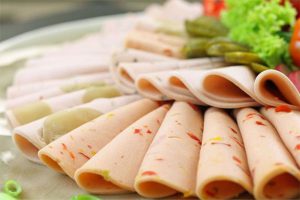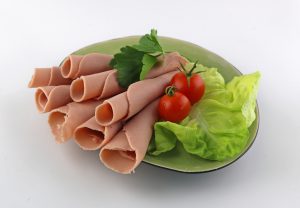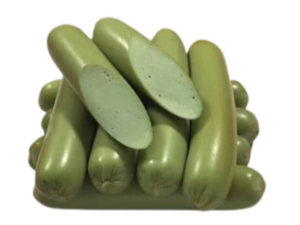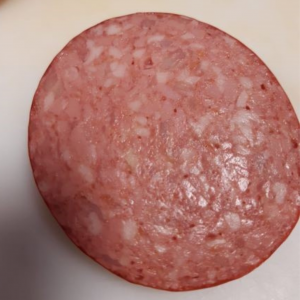The craft of stuffing Sausages
Sausage is really nothing more than a seasoned meat mixture in a sausage casing. But how do you get the meat mixture into the casing so that it retains its shape, flavour and texture?
People make mistakes when reading recipes, they get confused with grams and ounces, they use different sized spoons to measure out ingredients, etc. Therefore, always taste the sausage before filling it, because there is still time for last-minute adjustments. Just make a very small hamburger, about a quarter, throw it on a skillet and in two minutes you can taste your sausage.
After the meat is ground and mixed, it must be put into a casing, preferably as quickly as possible. By letting the meat rest overnight, it hardens and absorbs all the moisture we added during the mixing and stuffing process.
Because of the copious amount of salt in it, this trick will be performed and we will have trouble filling the intestines the next day. Such sausage masses should be remixed. Although sausage should be filled as tightly as possible, different types of sausage are still filled to different degrees of firmness for practical reasons:
The ample amount of salt inside will perform this trick and we’ll be struggling with stuffing the casings the next day. Such sausage masses should be remixed. Although sausage should be stuffed as tightly as possible, nevertheless for practical reasons different sausage types are stuffed to a different degree of firmness:
| Sausage type | Firmness | Remarks |
|---|---|---|
| Rope sausage. | Tight | Meat shrinks in time due to evaporation of the moisture. |
| Individual links, tied with twine or enclosed with clips. | Tight | Meat shrinks in time due to evaporation of the moisture. |
| Rope sausage manually linked into individual links by twisting. | Loosely | If stuffed tight, twisting will be difficult to perform. |
| Liver sausage, Blood sausage, Head cheese. | Loosely | These products are heated in water and casings may burst open. They often contain filler material (rice, oats, barley etc) which often expands in volume. |
The casing should have about a third of a cup of water inside as it acts as a lubricant for the entering meat. By the same token pouring water over the stuffing tube is recommended to increase lubrication. Some people grease the tube lightly. Don’t use water when making slow fermented sausages.
Use the largest stuffing tube which fits the casing but make sure it goes on loosely otherwise the casing might break. It is important to stuff sausages hard and without air as the resulting air pockets might fill with water or become little holes later.
When stuffing fermented and dry products, such moisture pockets will become breeding grounds for bacteria. Pack the meat tightly in the grinder, horn, or piston stuffer to prevent air from entering the casing. The air also creates unnecessary resistance during stuffing. Most vertical piston stuffers come equipped with an air valve that allows accumulating air to escape outside. After the sausage is stuffed, any accumulated air pockets visible to the naked eye are simply pricked with a needle.
It is a known fact that a smoked sausage will be of higher quality when the meat is seasoned overnight which is basically a shorter, simplified version of the curing process that should have been performed earlier. If you want to cure a sausage that way (why not to cure it the proper way), grind, mix and stuff it first, then it can be stored overnight in a refrigerator. Note that when a cold sausage will be transferred from a cooler to a warm room, the condensation will likely appear on its surface. Sausages that have been kept in the refrigerator overnight should be permitted to hang at room temperature for at least one hour before being placed in the smokehouse.
Recommended stuffing tube diameters
| Tube size | Casing diameter |
|---|---|
| 1/2” | 22-28 mm |
| 3/4” | 30-36 mm |
| 1” | 38 mm and over |
The natural casings are ideal casings for a home sausage maker though they require some practice. After the first sausage session they become easy to work with and are always ready to be used at a moment’s notice. Any remaining casings should be packed with canning salt and stored at refrigerator temperature (38 – 40° F) where they will last almost indefinitely.
The mixed sausage mass can firm up very fast and should be stuffed without much delay. To remove air commercial producers, perform mixing and stuffing under a vacuum at around 0º C (32º F), but this requirement will hardly be met in the home production of sausages.
Natural and synthetic casings are used if they allow moisture and smoke to go through. They must be able to cling to meat and shrink with it as it goes through the drying process. Natural casings may look solid but in reality, they contain minute holes (pores) that permit smoke or moisture to go through. If warm fat is ground, it starts to smear and clogs up those spores inhibiting drying.
Natural casings are salted and they must be prepared for stuffing:
- Desalt casing at least one hour in cold running water before use to eliminate salt and to make them pliable. They can be soaked in cold water for 30 min and then rinsed. Change water once or twice. Water should be of drinking quality.
- To reduce the possibility of any contamination by bacteria, rinse casings briefly (in and out) with vinegar.
- If during drying the outside of the sausage becomes greasy, it should be wiped off with a warm cloth otherwise it may inhibit drying.
Do not:
- De-salt casings with hot water.
- Store casings at high temperatures.
- De-salt casings for a prolonged period.
Steps such as meat cutting, grinding, mixing and stuffing should be done at temperatures below 12º C (54º F). If working at higher temperatures, try to plan and organize your work in such a way that the meats will be processed as fast as possible and then placed in a refrigerator. All preparatory sausage making steps such as meat cutting, mixing and stuffing should be performed at the lowest obtainable temperatures in the kitchen. If the premises are not temperature controlled, it is advisable to perform those duties at late evening or early morning hours.
If a sausage is stuffed into 32-, 36- or 38-mm hog casings its taste will obviously remain the same. The smoking and cooking times will change slightly but it will still be the same sausage. On the other hand it will be a different sausage if you start experimenting with new spice combinations or will add chicken meat to it. The casing is just a packing material and although some traditionally made products may look unusual if stuffed into casings less accustomed to us, they will taste the same. For example, pepperoni will look odd if stuffed into 24 mm sheep casings but it will still be.
Sausage stuffing Equipment
Stuffing sausages is labour intensive and the type of a stuffer used can make sausage making a pleasure or a difficult to perform chore. There is a distinct difference between stuffing requirements of a commercial meat plant, little butcher shop and a home sausage maker. Meat plants need a machine that will stuff, link and portion sausages in one cycle. Sausages must be of the same length and weight otherwise it would be impossible to estimate costs and run the business. Such machines are very expensive and can stuff thousands of pounds of sausage in one hour. The piston is powered by hydraulic pressure and the machine is controlled with a foot or a knee.
Butcher shops do not care much about linking and portioning sausages as the experienced sausage maker can fast link sausages by hand. Drawing on his experience he can estimate the weight of one foot of a particular diameter sausage. In addition the salesperson will weigh each order on a scale. What is important is that the stuffer performs faultlessly and is easy to operate and maintain. Such stuffers can be manually operated or can be hooked up to a motor.
Home sausage makers are concerned with the cost of the equipment and end up stuffing sausages with a grinder and the attached stuffing tube. This is a labour consuming operation that requires two persons. Recently, many manually operated piston stuffers (5-20 lbs. capacity) have entered the marketplace. They are inexpensive, reliable and some of them can be motorized.
There are several machines to stuff sausages:
- Grinder stuffer
- Horn stuffer
- Manual piston stuffer
- Hydraulic piston stuffer
Grinder Stuffer
The first known stuffer we know of was a simple funnel where casings were inserted on one end and the meat was pushed with fingers inside its opening. There still exists Polish sausage named “palcówka” (“palce” means fingers) that was done that way. The most popular method employed by home sausage makers is using hand cranked grinders with sausage tube attachments. It’s like in the example above with a difference that the meat grinder and not the fingers is pushing meat into the funnel. This arrangement has served us well for centuries, but it is a labour consuming operation normally requiring two persons.
Number #10 grinder with stuffing tube.
Number #10 grinder accepts different sized tubes.
Spacer. Knife and grinder plate are always removed for stuffing. It is a good idea to insert the spacer, although not necessary.
The knife and plate are removed from the grinder and the auger pushes meat into the stuffing tube. It wobbles quite a bit as it is not held in place by the plate which was removed. The optional spacer will provide support for the auger and the wobbling will stop. The main drawback of this arrangement is that it requires two persons to stuff the casing. One must insert meat into the mouth of the grinder and rotate the crank carefully not to loose the fingers. The second operator holds the tube and casing with his hand that works like a brake controlling speed and amount of meat that can be stuffed into the casing.
“Grześ” creating wonders using a museum-type stuffer.
“Papcio” is the Master of Working in a limited amount of space.
“Paweł” is another accomplished sausage maker.
Horn Stuffer
There is a small (3-5 lbs.) horn stuffer and although the device looks cute and original nevertheless from the practical point of view is not much better than the hand grinder with tubes. It still requires two people to do the stuffing, though a strong person might be lucky to do it by himself. It is our opinion than a serious hobbyist should invest in a vertical piston stuffer which will make stuffing faster and more enjoyable. The money that is saved by not buying an electrically operated grinder can be reinvested into a purchase of a piston stuffer. If you can afford it, buy all top-of-the-line industrial automated equipment, but keep in mind that a manual grinder is an incredibly efficient device that can be successfully deployed in any production that requires 20 pounds or less of sausage.
Photos courtesy The Sausagemaker, Buffalo, NY
Manual Piston Stuffer
Piston is manually raised up and the cylinder is detached from the base for loading. There isn’t any lid on top of the cylinder. The cylinder is inserted back into the base and the piston is lowered down. By cranking the handle the gear forces the piston down the cylinder pushing meat in through the stuffing tube. Any air that might be compressed by the piston and delivered into the sausage escapes through the air valve.
There is a little built-in air valve into the piston to allow a release of air pressure that normally will be pushed inside of the sausage creating air pockets, On the bottom side of the cylinder we have an opening that accepts different sizes of sausage tubes. One person can easily control the casing and sausage speed with one hand and turn the handle that moves the piston down with the other.
Photos Courtesy The Sausage maker, Buffalo, NY
Hydraulic Piston Stuffer
The lid is raised and the meat mass is loaded. Knee operated switch supplies hydraulic pressure to the piston which forces meat up to the stuffing tube.
SC-50 Hydraulic piston stuffer. Photo courtesy Koch Equipment, Kansas City, MO.
Volumetric portioner for constant sausage weight. Photo courtesy Koch Equipment, Kansas City, MO.
Frey F200 Vacuum Stuffer With Lift.
Stuffing and linking in progress.
Vacuum stuffers offer improved product quality (less smear and better particle definition) and consistency.
Photo’s courtesy Koch Equipment, Kansas City, MO.





